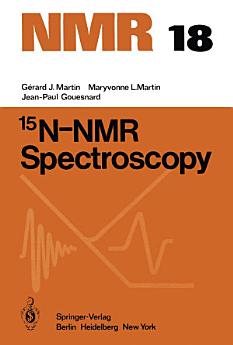15N-NMR Spectroscopy
G.J. Martin · M.L. Martin · J.-P. Gouesnard
ডিচে ২০১২ · NMR Basic Principles and Progress কিতাপ 18 · Springer Science & Business Media
১.০star
১ টা পৰ্যালোচনাreport
ইবুক
384
পৃষ্ঠা
reportমূল্যাংকন আৰু পৰ্যালোচনা সত্যাপন কৰা হোৱা নাই অধিক জানক
এই ইবুকখনৰ বিষয়ে
After the proton and carbon, nitrogen is, with oxygen, the most impor tant atom in organic and especially bioorganic molecules. However, the development of nitrogen spectroscopy is indeed very recent. This is due to the fact that nitrogen-14, which is the naturally abundant iso tope, suffers, for structural studies, from the disadvantages inherent in nuclei with a quadrupolar moment (Table 1.1). Actually, indirect 15N measurements were reported in the early days of double resonance spectroscopy and the first direct detection of 15N resonance signals at the natural abundance level was realized in 1964 (R 17) at 4.33 MHz 1 (~ 1T) using a 15 mm o.d. cell in the field sweep mode (~ 0.16 min- ). Signal-to-noise ratios only of 3-4 were obtained for neat liquids and this low sensitivity of the 15N resonance still remains the main dis advantage for 15 spectroscopy (Table 1.1). However, nitrogen-15 has, N probably more than any other nucleus, benefited from the advances of NMR technology, i.e. Fourier transformation, multinuclear facilities, wide-bore super conducting solenoids, and, with the new generation of spectrometers, 15N-NMR is entering the field of routine investigation. Nevertheless, in spite of these spectacular improvements, obtaining 15N spectra of diluted species or large biochemical molecules is often not very easy and a good knowledge of the relaxation properties pecu liar to 15N may be necessary in order to adjust the pulse sequences and the decoupler duty cycle correctly (Section 2).
মূল্যাংকন আৰু পৰ্যালোচনাসমূহ
১.০
১ টা পৰ্যালোচনা
এই ইবুকখনক মূল্যাংকন কৰক
আমাক আপোনাৰ মতামত জনাওক।
পঢ়াৰ নির্দেশাৱলী
স্মাৰ্টফ’ন আৰু টেবলেট
Android আৰু iPad/iPhoneৰ বাবে Google Play Books এপটো ইনষ্টল কৰক। ই স্বয়ংক্রিয়ভাৱে আপোনাৰ একাউণ্টৰ সৈতে ছিংক হয় আৰু আপুনি য'তে নাথাকক ত'তেই কোনো অডিঅ'বুক অনলাইন বা অফলাইনত শুনিবলৈ সুবিধা দিয়ে।
লেপটপ আৰু কম্পিউটাৰ
আপুনি কম্পিউটাৰৰ ৱেব ব্রাউজাৰ ব্যৱহাৰ কৰি Google Playত কিনা অডিঅ'বুকসমূহ শুনিব পাৰে।
ই-ৰীডাৰ আৰু অন্য ডিভাইচ
Kobo eReadersৰ দৰে ই-চিয়াঁহীৰ ডিভাইচসমূহত পঢ়িবলৈ, আপুনি এটা ফাইল ডাউনল’ড কৰি সেইটো আপোনাৰ ডিভাইচলৈ স্থানান্তৰণ কৰিব লাগিব। সমৰ্থিত ই-ৰিডাৰলৈ ফাইলটো কেনেকৈ স্থানান্তৰ কৰিব জানিবলৈ সহায় কেন্দ্ৰত থকা সবিশেষ নিৰ্দেশাৱলী চাওক।








